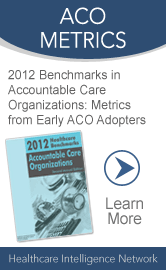 |
Issue #6-3 | November 29, 2012

How hospitals can survive in the new health value chainMore hospitals will be absorbed into larger systems amid healthcare reform, reveals an analysis by Brown Gibbons Lang & Co. (BGL), an independent investment banking advisory firm. The primary driver of this increased consolidation will be an emphasis on quality of care at the lowest cost. That means hospitals and other healthcare market participants will have to think outside the box to survive and grow. What to consider: Reimbursement changes and the migration to accountable care are pushing providers to transform the healthcare delivery model, favoring comprehensive, integrated delivery systems that improve quality of care and control costs, says BGL. That means more consolidation, so industry participants are exploring ways to partner together to cement their roles in the new health value chain. Here are the primary strategies:
Healthcare reform will continue to drive consolidation and change the competitive landscape as new partnerships are formed and nontraditional players enter the market, says BGL. Crucial time for new Medicare payment model Payment reform is one of the toughest challenges facing hospital financial managers. In any industry going through massive regulatory changes, it’s important for industry participants to help shape the new rules as much as possible. This is going on now with respect to certain new changes in Medicare payments to healthcare providers. A pilot program has 100 hospitals testing a new Medicare payment scheme designed to reward hospitals for better coordinating care for patients after they leave the hospital, resulting in reduced costs of readmissions. However, these rewards may not be optimal unless the financial details can be hammered out, says a recent article from the New England Journal of Medicine (NEJM). This past August, the Center for Medicare & Medicaid Innovation of the Centers for Medicare & Medicaid Services (CMS) announced a bundled payments for care improvement initiative that will begin in January 2013. The program will link payments for multiple services that patients receive during their complete “episode” of care. This is designed to encourage hospitals to take an active role in how patients are cared for after they are discharged. Four options: According to the NEJM, 100 hospitals are participating in the pilot, and they will choose from four new payment models. “The first model bundles payments for hospital and physician services during a hospitalization. The second model bundles payments for hospitalization and all post-acute care services for up to 180 days after discharge. The third model bundles payments for post-acute care services after hospitalization but doesn't include the hospital stay. The fourth model sets a fixed prospective payment for all services during a hospitalization plus readmissions within 30 days,” according to the article. As part of the program, CMS provided detailed Medicare claims data to prospective applicants so that they could build episodes and calculate historical prices. Based on this, CMS will set target prices for each episode, but continue to pay for care at Medicare's fee-for-service rates. Then, CMS will assess whether actual spending for each organization's episodes is above or below the target amount. Those below the target will receive additional payments, and those exceeding it must return the excess amount to CMS. This was a rare opportunity to historically analyze what happens to Medicare patients after they leave the hospital. There were two key findings: (1) Medicare typically spends as much or more in the 90 days after discharge as it spends for an initial hospitalization; and (2) the data shows wide variation in average post-acute care spending. Opportunity: Spending variation highlights opportunities for hospitals and their partners to improve quality and reduce spending by reaching out to patients after discharge. The data that pilot program applicants receive from CMS can help them identify partners by showing where their patients receive services and at what cost. This can help hospitals build stronger clinical relationships with these providers. However, this variation can also pose financial risks for participating hospitals. That’s because if there is a relatively small number of patients within each type of episode, there can be a substantial year-to-year variation in the severity of illness in, and costs for, patients who require treatment. Crucial time: CMS has begun to discuss changes to the proposed financial model with pilot program applicants. The new scheme will have to protect against losses resulting from both random and systematic variation in illness severity. Certain design features will have to be considered, such as risk adjustment, stop-loss protection for high-cost cases, an ability to exclude cases with high-cost primary diagnoses from episode definitions, and mechanisms that allow hospitals to share both gains and losses as they acclimate to the program. Unless changes are made, hospitals will not be confident that the program will financially reward successful clinical performance. Savvy ACOs knit together financial and clinical IT New research reveals that healthcare organizations with integrated clinical and financial IT systems have a leg up when moving to the accountable care organization (ACO) model under health reform. Leavitt Partners (Salt Lake City) surveyed 320 ACOs, and KLAS (Orem, Utah), conducted interviews with leaders of 60 organizations, reports InformationWeek. They say they need clinical information systems that can enable them to do population health management (PHM), a systematic approach to coordinate patient care across a group in order to improve clinical and financial outcomes. But the systems they are buying range from general business intelligence software (Oracle, IBM) to very targeted applications (Medventive, Wellcentive, Phytel). The trouble is, the PHM software market has not fully developed, so there is no dominant vendor. What’s more, the functionality and the offerings are very fragmented, according to Colin Buckley, strategic operations director for KLAS. Many ACOs (60% of respondents) say the use of electronic patient registries is a key part of their care coordination strategy. Some ACOs view the registries as a part of their electronic health record systems, which could generate lists of patient subgroups and information about their health status. Other ACOs use third-party software, and some large organizations have designed their own registries for use with their sophisticated data warehouses. Integration critical: More than three quarters of the respondents said that clinical systems integration was critical or important. This integration is between inpatient and outpatient clinical and financial information within an enterprise, rather than across multiple provider entities. Many ACOs feel it is important to move to a vendor such as Epic or Cerner that has all of the pieces connected and stores information in a single database, according to Buckley. This is preferable to “having one vendor for the hospital, several in the ambulatory sites, and other best-of-breed products that they would have to tie together," he said. Access to fragmentary data on some patients is not good enough for ACOs. “They need the data ahead of time and they need it to be comprehensive and as up to date as possible,” said Buckley. “It's just not working that way for the majority of organizations that don't have an integrated system like a Cerner or an Epic." ACO Guide: To get an overview of ACOs, Healthcare Intelligence Network’s Essential Guide to Accountable Care Organizations answers key questions so that hospitals; PHOs; IPAs; and other physician organizations, networks, or group practices can assess market position and readiness for the ACO model and move quickly to improve profitability and market share. Hospital deals propel nonprofit healthcare M&As Hospital systems have figured prominently in the largest deals that involved the sale of a not-for-profit healthcare organization or asset, reveals a new report.During the Jan. 1, 2007, to June 30, 2012, period, a total of 432 transactions were recorded in which a buyer targeted a not-for-profit organization either as a merger partner or an outright acquisition target, according to The Not-For-Profit Acquisition Report, third edition, 2012, from Irving Levin Associates (Norwalk, Conn.). The majority of deals occurred within the hospital sector, followed in order of descending deal volume by long-term care, behavioral healthcare, home healthcare, biotechnology, and other services. Also within the time frame, a combined total of 29 deals were announced in the healthcare technology segment. Of the top 10 deals, eight involved the acquisition of a not-for-profit hospital by another hospital organization. The other two involved the acquisition of royalty interests in the pharmaceutical products Lyrica and Remicade, sold by Northwestern University and New York University, respectively. |
|
||||||
1000 SW Broadway, Suite 1200, Portland, OR 97205
(503) 291-7963 | editor@bvhealthcarenews.com
www.BVResources.com/healthcare

